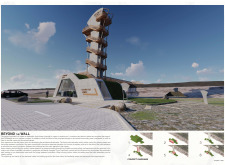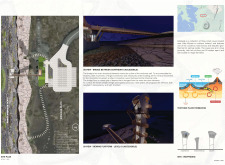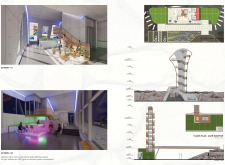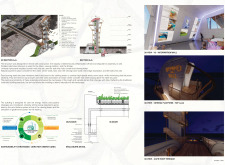5 key facts about this project
Integration with Natural Landscape
The visitor center is constructed from poured-in-place concrete, which allows the structure to blend with the rocky terrain. The use of this material minimizes visual disruption while ensuring durability. The viewing tower, characterized by cantilevered platforms, enables visitors to access panoramic views of the landscape, creating a direct relationship between the visitors and the geological formations. Its design mirrors the verticality seen in local topography, cohesively linking the architecture to its surroundings.
Another unique aspect is the bridge connecting the two tectonic plates, which not only facilitates physical movement but also symbolizes the geological relationship between them. Built with a robust steel grid framework, the bridge is designed to withstand the region’s extreme weather conditions while maintaining visual transparency through mesh plating.
Sustainability and Environmental Considerations
Sustainability is at the forefront of the design approach. The project incorporates a Zero Net Energy philosophy, focusing on energy-efficient strategies such as geothermal heating and wind energy harnessing. The choice of materials, from triple-pane insulated curtain walls to green roofs, reflects a commitment to minimizing the ecological footprint. The landscaping includes native vegetation, further enhancing the building's integration with its environment.
Interactive Learning Spaces
Inside the visitor center, the architectural design includes an Information Wall that provides interactive learning opportunities. This designated area displays digital content related to the geological features of the surrounding landscape, enhancing visitor engagement and education. Through intuitive design elements, such as accessible pathways and open layouts, the project encourages exploration and interaction.
Visitors are invited to study architectural plans, sections, and design details that showcase the thoughtful integration of structural components and environmental considerations. The architectural ideas in this project exemplify a balanced approach to modern design, seeking to educate and connect people with the natural world they inhabit.
For a deeper exploration of the architectural designs and innovative elements of the "Beyond the Wall" project, reviewing the detailed architectural plans and sections will provide further insights into its unique attributes and functional suitability.


























